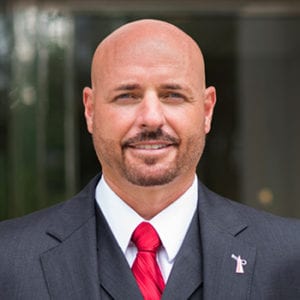Coaching clients as they prepare for their financial future

Mark Thompson • Greenfield, WI
ClearStep Financial • Harbour Investments Inc.
Read full biography below

Our six-step planning process is disciplined and comprehensive. I especially enjoy beginning that process with clients—introducing our firm and my practice, explaining how we like to work with clients, reviewing some key financial-education concepts, and getting to know individuals or couples.
 We first go through a financial discovery process, taking inventory of a client’s total financial picture. We help them assess their objectives, and identify potential gaps in their insurance needs or their longer-term financial-planning imperatives. I believe we can bring our clients the “best of both worlds.” We offer the tremendous resources of the Harbour Investments/ClearStep Financial organizations while still operating independently. We have the freedom to recommend products and services from a wide variety of high-quality providers.
We first go through a financial discovery process, taking inventory of a client’s total financial picture. We help them assess their objectives, and identify potential gaps in their insurance needs or their longer-term financial-planning imperatives. I believe we can bring our clients the “best of both worlds.” We offer the tremendous resources of the Harbour Investments/ClearStep Financial organizations while still operating independently. We have the freedom to recommend products and services from a wide variety of high-quality providers.
I explain to clients that we are working as a team to develop their financial strategy. I ask questions that will help identify what’s most important to them in planning their financial future, such as, “What are your hopes and dreams? What is your risk tolerance? Are your risk tolerance and current financial status in line with your objectives? Do you need to be growth-oriented, or is it important to you to have guaranteed income in retirement?”
The discovery process allows me to assemble appropriate options, and then we review the pros and cons of those options. There are so many ways to get to an objective, so I strive to make sure my clients are well-informed about their options. We can then intelligently walk through the decision-making together. We work as a team because, at the end of the day, the client is the owner of their financial strategy, and I am their coach throughout the entire process. I ask the questions that need to be answered to present viable options. But, ultimately, they will be the ones giving me the green light to proceed with a course of action.

For many clients, this is a new way of thinking about their long-term investment strategy. Most know only about passive buy-and-hold approaches to the markets. The financial media has reinforced this, stressing that the S&P 500 is the benchmark for investment performance. In my opinion, that is wrong on so many levels. I cannot imagine any client wanting to have 100% exposure to one index and one asset class—that makes no sense at all to me. When I discuss historic market returns for the S&P 500 with clients facing retirement, most see that they do not want their hard-earned assets fully exposed to an index that can suffer significant losses in any given year.
 This is how I generally begin discussing the use of active and risk-managed strategies with clients. We also discuss other aspects of an actively managed approach. With the managers I use, I can show a client an active strategy or a combination of strategies and illustrate performance over the past 10 years. It is particularly important how these strategies perform in down markets, such as the 2008 credit crisis.
This is how I generally begin discussing the use of active and risk-managed strategies with clients. We also discuss other aspects of an actively managed approach. With the managers I use, I can show a client an active strategy or a combination of strategies and illustrate performance over the past 10 years. It is particularly important how these strategies perform in down markets, such as the 2008 credit crisis.
I let clients know that risk-managed strategies generally do have trade-offs. These strategies usually will not capture all of the upside of a very strong market year, but they also are constructed to help minimize losses in severe bear markets. This provides three major benefits for clients: (1) the psychological benefit of knowing their investment strategy is predicated on smoothing out volatility, (2) the tangible mathematical and compounding benefit helps to manage volatility in their portfolio, and (3) having an investment strategy that is customized to their risk tolerance.
Over the long term, these factors become very important for clients in staying with their investment plan and seeing progress toward their goals. This is the type of investment management that used to be reserved only for wealthy investors. We have dozens of strategies and many professional money managers that are available to our clients. These managed accounts can now be brought by our firm to clients with relatively modest accounts.
I do have one niche opportunity that has been rewarding for both the clients involved and our practice. I have been working with a company that offers its employees an attractive employee stock option plan. While I work with all levels of employees in the company, a good number are blue-collar workers who have put in many years with the company. The assets they have accumulated over the years can be quite significant.
This becomes an interesting planning situation as these individuals consider planning for retirement. While they may have decent salaries, few have ever thought of themselves as wealthy. Given the stock they have accumulated, they may now have the ability to retire much earlier than they ever considered possible. Some people are interested in starting a second career or running their own business. Some want to relocate or buy a vacation home. Just about all of them need education and guidance on tax implications and legacy planning, areas they may never have been concerned with before.
These workers represent a target market that is receptive to hearing about our practice’s message about financial and investment strategies. They are interested in our risk-management approach, wanting to preserve and grow their assets. The word-of-mouth referrals we receive within the company are very gratifying. I feel privileged to have this opportunity, and I look forward to working with this company’s employees for many years to come.
 Mark Thompson is an investment advisor representative with Harbour Investments Inc., based in Madison, Wisconsin. Mr. Thompson has over 20 years of experience and says he “enjoys working with clients from all walks of life and helping many different types of people plan for a more secure financial future.”
Mr. Thompson is a native of Wisconsin and has lived there almost his entire life. He was raised in “a great, supportive family environment” and shares his parents’ love of the “beautiful Wisconsin outdoors.” Mr. Thompson was a highly recruited baseball player coming out of high school and attended the University of South Alabama, where he played baseball in a “tough Division I schedule against some future major leaguers.” He finished his undergraduate work at the University of Wisconsin–Oshkosh, where he majored in physical education and earned a teaching degree.
After spending several years in sales and manufacturing positions, Mr. Thompson was recruited into the financial-services industry. He says he appreciates “receiving excellent training and the full support of several experienced advisors as mentors.” He became a full-time financial advisor in 2006 and has built his practice steadily since then, winning recognition within Harbour Investments/ClearStep Financial for assets under management.
Mr. Thompson has been married since July 2017. In his spare time, he enjoys hunting, fishing, and going to baseball games of all levels.
Disclosure: Securities and advisory services offered through Harbour Investments Inc., member FINRA/SIPC. There is no guarantee that active management will outperform a buy-and-hold approach to investing. Past performance is no guarantee of future results. Please note that individual situations can vary. Therefore, the information presented here should only be considered an opinion/example.
Photography by Nick Berard
Mark Thompson is an investment advisor representative with Harbour Investments Inc., based in Madison, Wisconsin. Mr. Thompson has over 20 years of experience and says he “enjoys working with clients from all walks of life and helping many different types of people plan for a more secure financial future.”
Mr. Thompson is a native of Wisconsin and has lived there almost his entire life. He was raised in “a great, supportive family environment” and shares his parents’ love of the “beautiful Wisconsin outdoors.” Mr. Thompson was a highly recruited baseball player coming out of high school and attended the University of South Alabama, where he played baseball in a “tough Division I schedule against some future major leaguers.” He finished his undergraduate work at the University of Wisconsin–Oshkosh, where he majored in physical education and earned a teaching degree.
After spending several years in sales and manufacturing positions, Mr. Thompson was recruited into the financial-services industry. He says he appreciates “receiving excellent training and the full support of several experienced advisors as mentors.” He became a full-time financial advisor in 2006 and has built his practice steadily since then, winning recognition within Harbour Investments/ClearStep Financial for assets under management.
Mr. Thompson has been married since July 2017. In his spare time, he enjoys hunting, fishing, and going to baseball games of all levels.
Disclosure: Securities and advisory services offered through Harbour Investments Inc., member FINRA/SIPC. There is no guarantee that active management will outperform a buy-and-hold approach to investing. Past performance is no guarantee of future results. Please note that individual situations can vary. Therefore, the information presented here should only be considered an opinion/example.
Photography by Nick Berard
